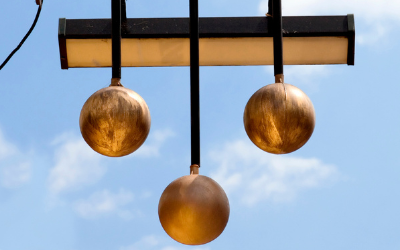What Is The Symbol For A Pawn Shop?

Have you ever gone down to your local pawn shop and wondered why their signage includes three golden balls? You’re not alone. Pawn shops have been around for thousands of years and have a rich history, including a traditional symbol with a possible mythical meaning behind it.
According to the National Pawnbrokers Association, pawnbroking is humanity’s oldest financial institution. Institutions offering pawnbroking have been traced back 3,000 years in cultures including China and early Greeks and Romans. Several prominent European families gained notoriety for being pawnbrokers, and even royalty was known to pawn their valuables to finance their pet projects.
In the United States, there are more than 12,000 pawn shops keeping the legacy of pawnbrokers going strong.
What is a Pawn Shop?
Those who haven’t watched any marathons of Pawn Stars, a popular show on cable TV about a 24-hour pawn shop in Las Vegas, may be wondering, “what is a pawn shop, and how does it work?”
A pawn shop is a place where the business owner offers low-interest cash loans with their customers using their personal property as collateral. If the customer comes back for their items, they pay back the loan plus a small fee, but if they don’t return after a stated deadline, their items become property of the pawn shop. Then, their items usually go up for sale in the shop. Most pawn shops offer 30- or 90-day loans at around 20 percent interest, using the client’s property as collateral.
These shops serve as a kind of bank and have been used for several purposes throughout the ages. For the extremely poor, pawning personal items like clothing provided some cash to get through the week and make it to payday, and for more wealthy individuals, the cash from a pawnbroker could be used as startup funds for a business or other endeavors. In the late 1300s, King Edward III of England pawned the royal jewels to pay soldiers in a war against France. Queen Isabella of Spain also pawned her jewels in a time of need, possibly using the money to fund the expeditions of Christopher Columbus.
In the 13th century in Britain, Franciscan friars used pawn shops as a way to help the poor, according to the BBC.
Pawn shops have stood for financial institutions when the banks are failing, as well. During the Great Depression in the United States, pawn shops were the only places many people could get cash. And more recently, during the years after the 2008 Great Recession, pawn shops thrived despite national financial instability as clients sought options for quick cash. Though failing to return for their items might be considered defaulting on the loan, it doesn’t affect clients’ credit scores.
Throughout recent history, various regulations have been put in place to standardize pawn shop policy and protect pawnbrokers from legal trouble if clients try to sell stolen goods. In England, the Pawnbrokers Act of 1872 set the limit for interest rates on collateral and provided guidelines for all pawn shops. The National Pawnbrokers Association, established in 1988, serves to enforce that pawn shops’ contracts are upheld and protects pawnbrokers’ interests.
Why is it Called a Pawn Shop?
The word pawn evolved from the Latin word platinum, meaning cloth or clothing, according to the History Channel. Though today people might think of jewelry, valuables, collectibles and electronics as the main items offered on pawn shops’ shelves, throughout history, clothing was often the most valuable item working class people had to offer as collateral.
While there is another use of the word pawn, as a chess piece or someone used to further the purposes of another, that meaning evolved from the Old French word “paon,” which means foot soldier. That meaning of the word pawn has nothing to do with pawnbrokers and pawn shops!
What Do the 3 Balls on a Pawn Shop Mean?
There was a time in European history when most of the population did not know how to read or write, so shopkeepers used symbols common among types of services to let prospective customers know what was inside their doors. The traditional symbol for a pawn shop is three gold balls suspended from a bar.
There are a few myths and legends surrounding the symbol for pawn shops. One harks back to St. Nicholas, often called the patron saint of pawnbroking. He is said to have left three bags of gold to a family with daughters so they could afford to marry, avoiding less savory fates. Those three bags of gold evolved into gold balls over time.
Another legend comes from one of the most famous pawnbroking families in history, the Medici family in Florence, Italy. This legend claims a member of the Medici family hired Charlemagne, the first emperor of the holy Roman empire, to slay a giant using three bags of rocks. Another possible origin for the symbol is that the shapes represent the currency at the time.
What Are the Names for Pawn Shop Owners?
Pawn shop owners have come to gather several different nicknames throughout history. During the time of the Medicis and for years thereafter, a family operating pawnbroker services was known as a family of Lombard, referring to the area where the Medici family lived.
Owners of pawn shops in England gained the nickname “Uncle,” from the Cockney dialect of English in the London area. The 17th century nursery rhyme “Pop Goes the Weasel” originates from London and is a song about pawning or “popping” goods.
Whether you call them by their names, “Uncle,” or pawnbroker, it’s clear that pawn shops have served a purpose throughout history and continue to provide that purpose to people of all economic backgrounds to this day.

